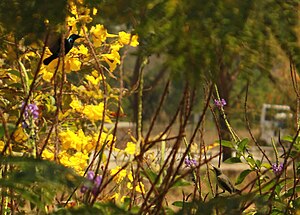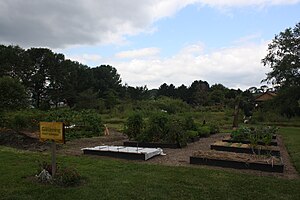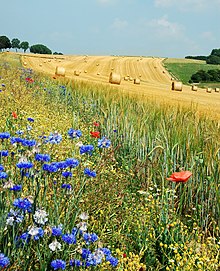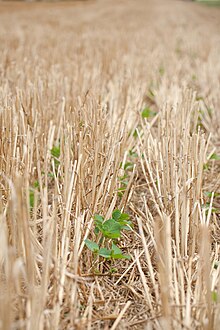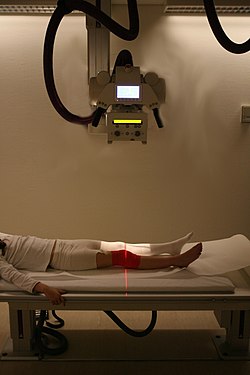Regenerative agriculture is a conservation and rehabilitation approach to food and farming systems. It focuses on topsoil regeneration, increasing biodiversity, improving the water cycle, enhancing ecosystem services, supporting biosequestration, increasing resilience to climate change, and strengthening the health and vitality of farm soil. Practices include recycling as much farm waste as possible and adding composted material from sources outside the farm.
Regenerative agriculture on small farms and gardens is often based on philosophies like permaculture, agroecology, agroforestry, restoration ecology, keyline design, and holistic management. Large farms tend to be less philosophy driven and often use "no-till" and/or "reduced till" practices.
On a regenerative farm, yield should increase over time. As the
topsoil deepens, production may increase and fewer external compost
inputs are required. Actual output is dependent on the nutritional value
of the composting materials and the structure and content of the soil.
Roots
Regenerative agriculture is based on various agricultural and ecological practices, with a particular emphasis on minimal soil disturbance and the practice of composting. Maynard Murray had similar ideas, using sea minerals. Her work led to innovations in no-till practices, such as slash and mulch in tropical regions. Sheet mulching is a regenerative agriculture practice that smothers weeds and adds nutrients to the soil below.
In the early 1980s, the Rodale Institute began using the term ‘regenerative agriculture’. Rodale Publishing formed the Regenerative Agriculture Association, which began publishing regenerative agriculture books in 1987 and 1988.
By marching forward under the banner of sustainability we are, in effect, continuing to hamper ourselves by not accepting a challenging enough goal. I am not against the word sustainable, rather I favor regenerative agriculture.
However, the institute stopped using the term in the late 1980s, and it only appeared sporadically (in 2005 and 2008), until they released a white paper in 2014, titled "Regenerative Organic Agriculture and Climate Change". The paper's summary states, “we could sequester more than 100% of current annual CO2 emissions with a switch to common and inexpensive organic management practices, which we term 'regenerative organic agriculture.'” The paper described agricultural practices, like crop rotation, compost application, and reduced tillage, that are similar to organic agriculture methods.
Storm Cunningham documented the beginning of what he called "restorative agriculture" in his first book, The Restoration Economy. Cunningham defined restorative agriculture as, a technique that rebuilds the quantity and quality of topsoil, while also restoring local biodiversity (especially native pollinators) and watershed function. Restorative agriculture was one of the eight sectors of restorative development industries/disciplines in The Restoration Economy.
2010s onward
Charles Massy published a book framing regenerative agriculture as a savior for the earth.
Allan Savory gave a TED talk on fighting desertification and reversing climate change in 2013. He also launched The Savory Institute, which educates ranchers on methods of holistic land management.
Abe Collins created LandStream to monitor ecosystem performance in regenerative agriculture farms.
Eric Toensmeier had a book published on the subject in 2016.
Principles
Principles include:
- Increase soil fertility.
- Work with whole systems (holistically), not isolated parts, to make changes to specific parts.
- Improve whole agro-ecosystems (soil, water, and biodiversity).
- Connect the farm to its larger agro-ecosystem and region.
- Make holistic decisions that express the value of farm contributors.
- Each person and farm is significant.
- Make sure all stakeholders have equitable and reciprocal relationships.
- Payment can be financial, spiritual, social, or environmental capital ("multi-capital"). Relationships can be "non-linear" (not reciprocal): if you do not get paid, in the future you can be given other "capital" by unrelated parties.
- Continually grow and evolve individuals, farms, and communities.
- Continuously evolve the agro-ecology.
- Agriculture influences the world.
Practices
Practices include but are not limited to:
- Permaculture design
- Aquaculture
- Agroecology
- Agroforestry
- Soil food web
- Livestock: well-managed grazing, animal integration and holistically managed grazing
- Sheer, total and utter neglect (STUN) breeding
- Keyline subsoiling
- Conservation farming, no-till farming, minimum tillage, and pasture cropping
- Cover crops & multi-species cover crops
- Organic annual cropping and crop rotations
- Compost, compost tea, animal manures and thermal compost
- Natural sequence farming
- Grassfed livestock
- Polyculture and full-time succession planting of multiple and inter-crop plantings
- Borders planted for pollinator habitat and other beneficial insects
- Biochar/terra preta
- Ecological aquaculture
- Perennial crops
- Silvopasture
- Alternative food networks (AFNs), commonly defined by attributes such as the spatial proximity between farmers and consumers.
- Home gardens, to mitigate the adverse effect of global food shocks and food price volatilities. Consequently, there is much attention towards home gardens as a strategy to enhance household food security and nutrition.
- Regrowing vegetables, for recycling and sustainable living.
Criticism
Some claims made by proponents of regenerative agriculture have been criticized as exaggerated and unsupported by evidence by some members of the scientific community.
One of the famous proponents of regenerative agriculture, Allan Savory has claimed in his TED talk that holistic grazing could reduce carbon dioxide levels to pre-industrial levels in a span of 40 years. According to Skeptical Science, "it is not possible to increase productivity, increase numbers of cattle and store carbon using any grazing strategy, never-mind Holistic Management [...] Long term studies on the effect of grazing on soil carbon storage have been done before, and the results are not promising.[...] Because of the complex nature of carbon storage in soils, increasing global temperature, risk of desertification and methane emissions from livestock, it is unlikely that Holistic Management, or any management technique, can reverse climate change."
According to a 2016 study published by the University of Uppsala, the actual rate at which improved grazing management could contribute to carbon sequestration is seven times lower than the claims made by Savory. The study concludes that holistic management cannot reverse climate change. A study by the Food and Climate Research Network in 2017 has concluded that Savory's claims about carbon sequestration are "unrealistic" and very different from those issued by peer-reviewed studies.
